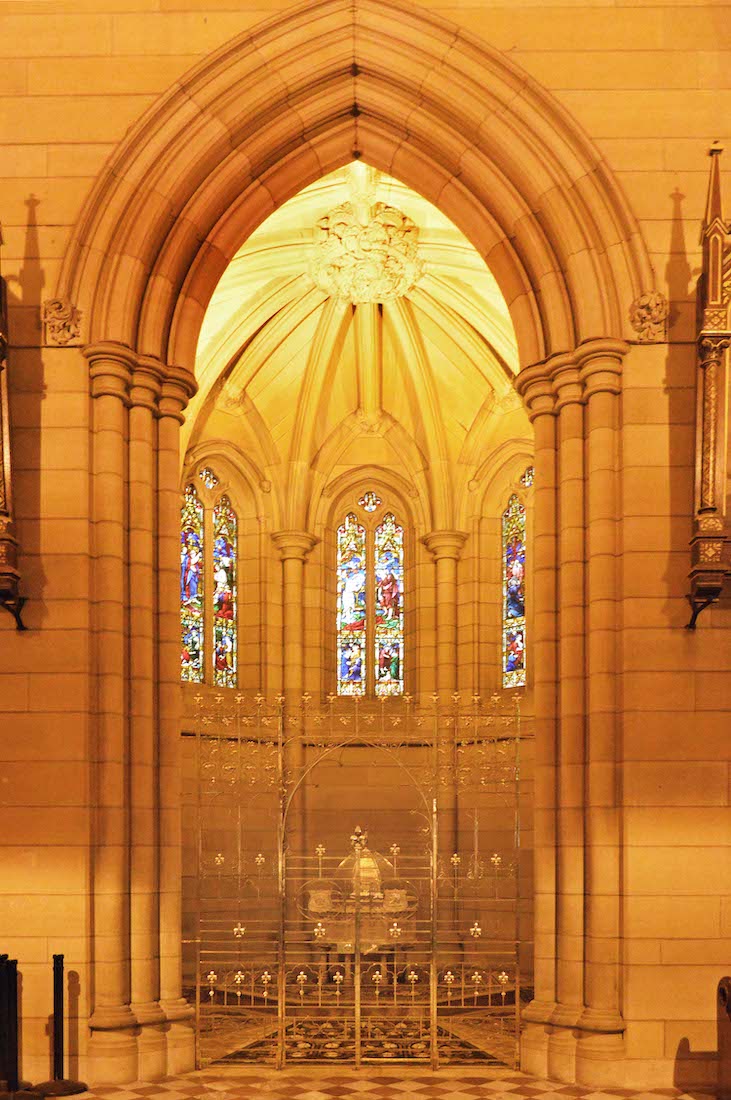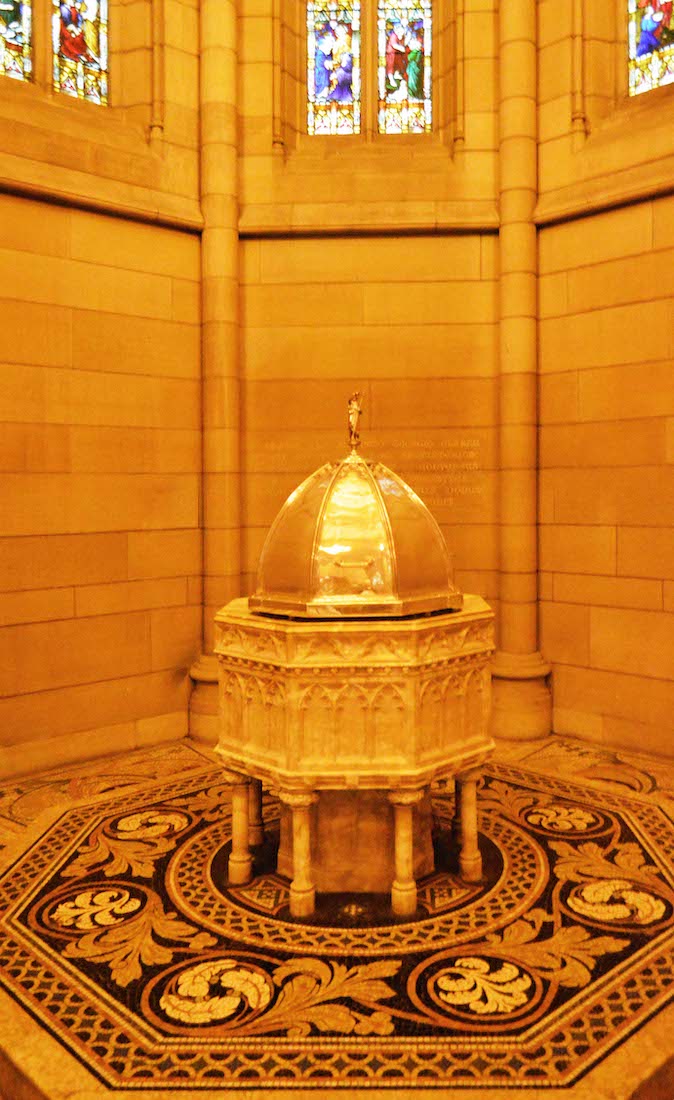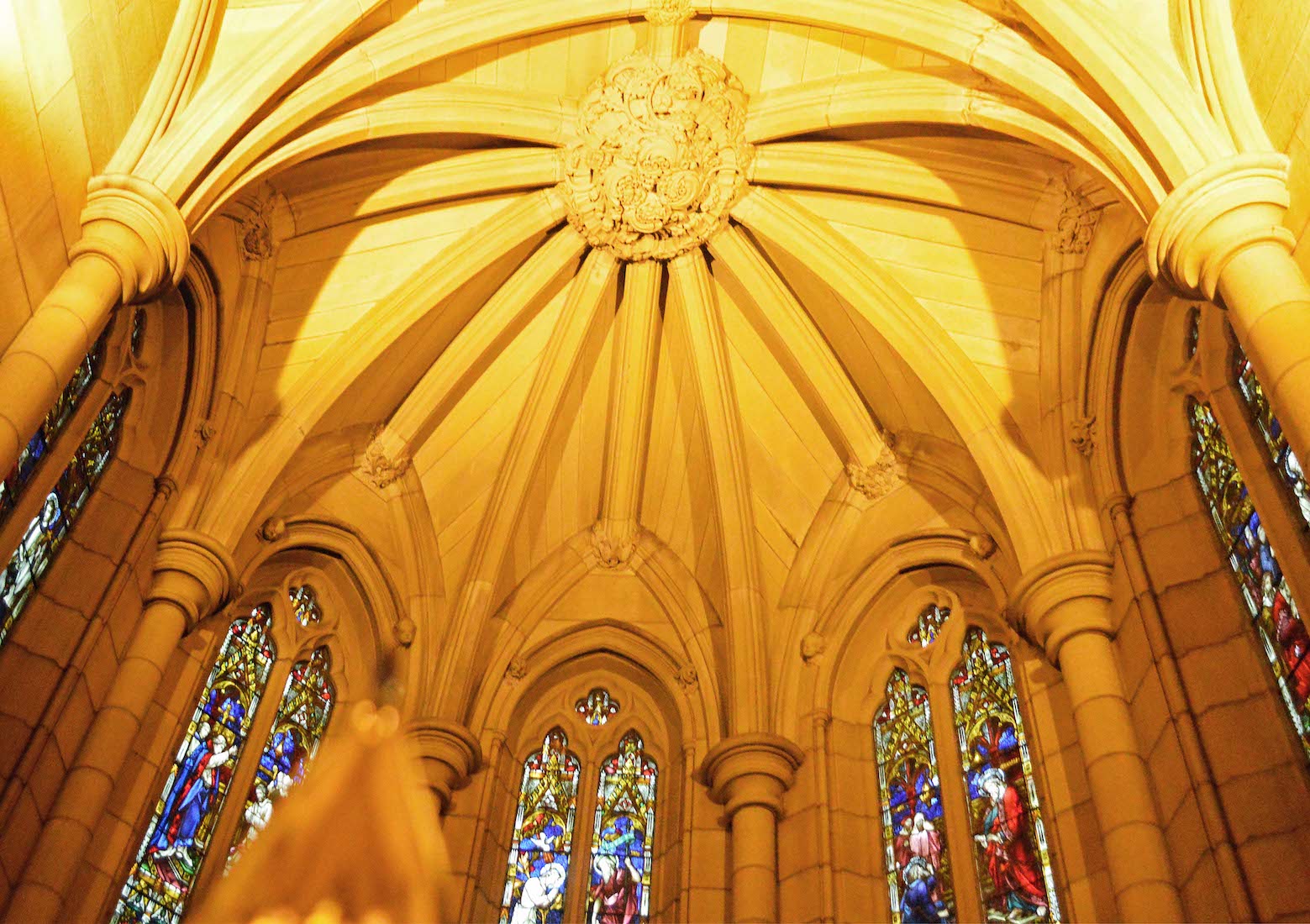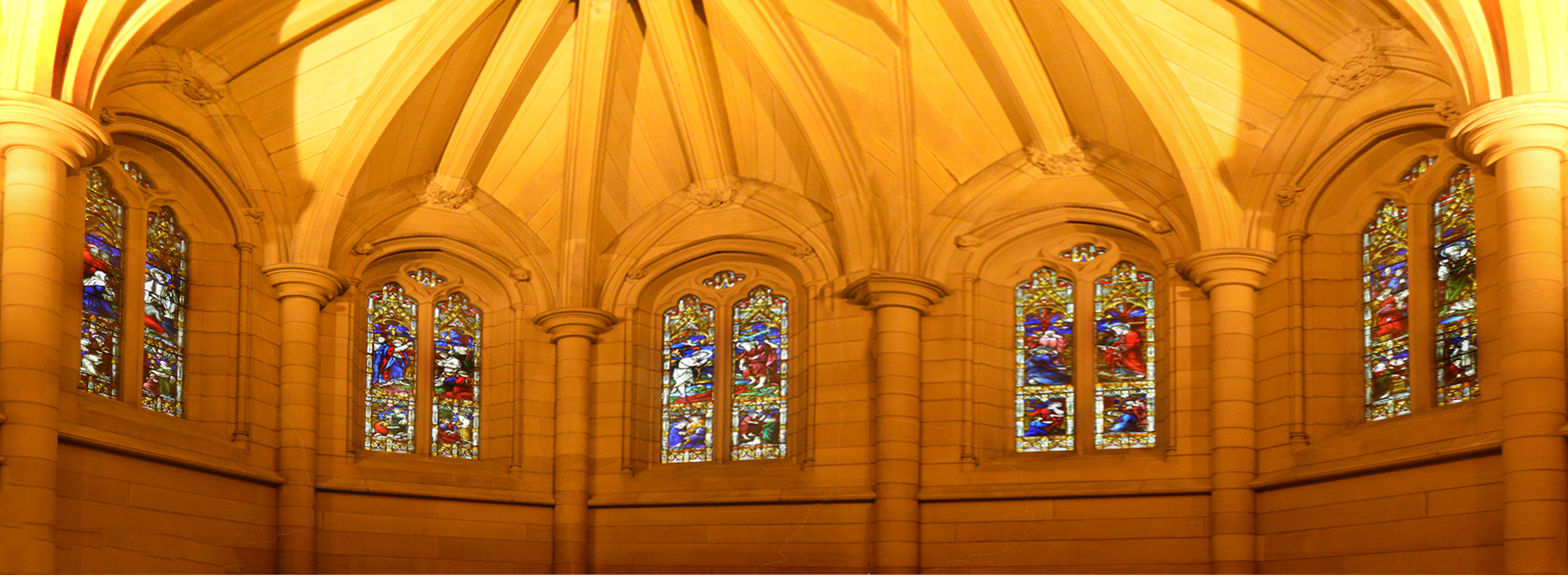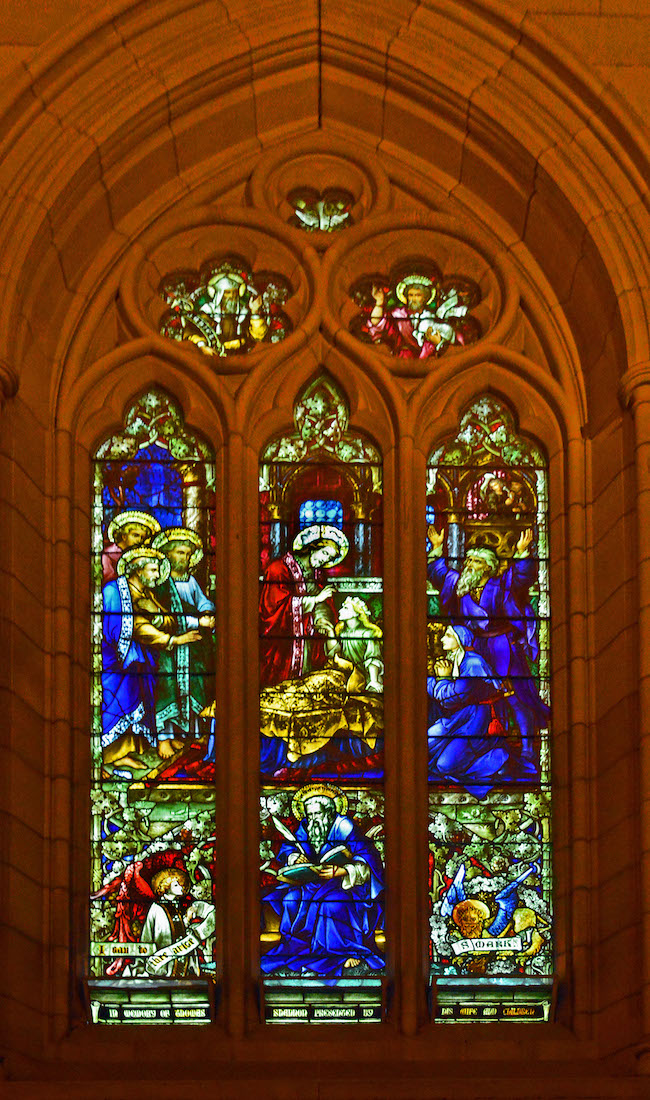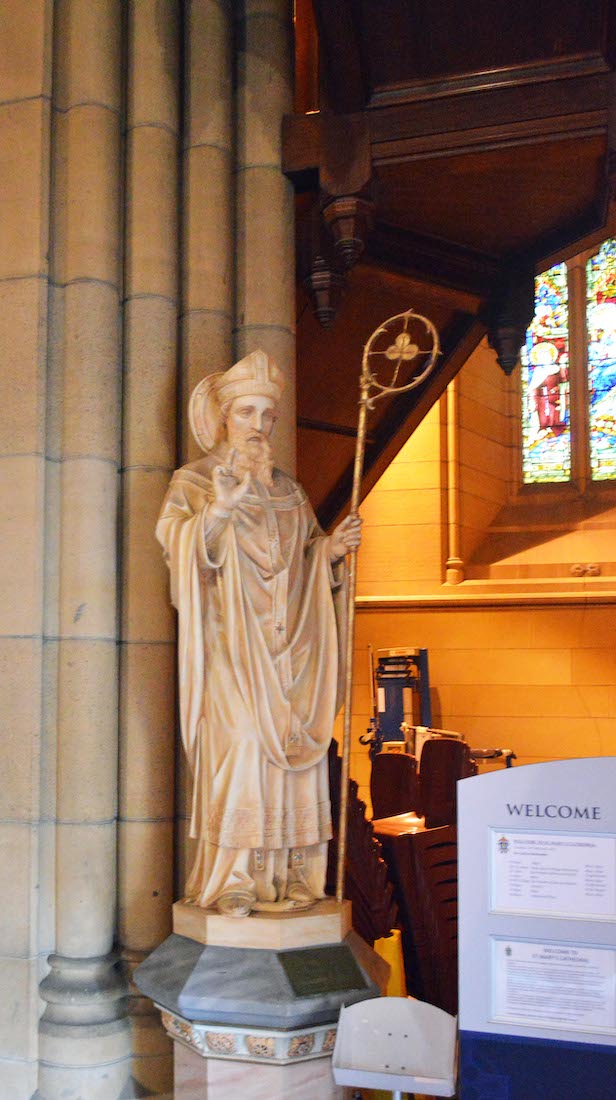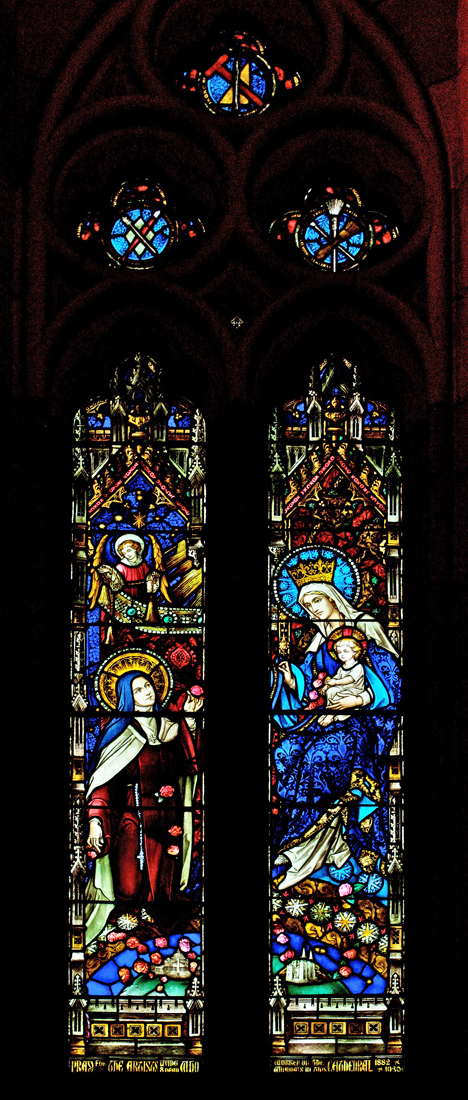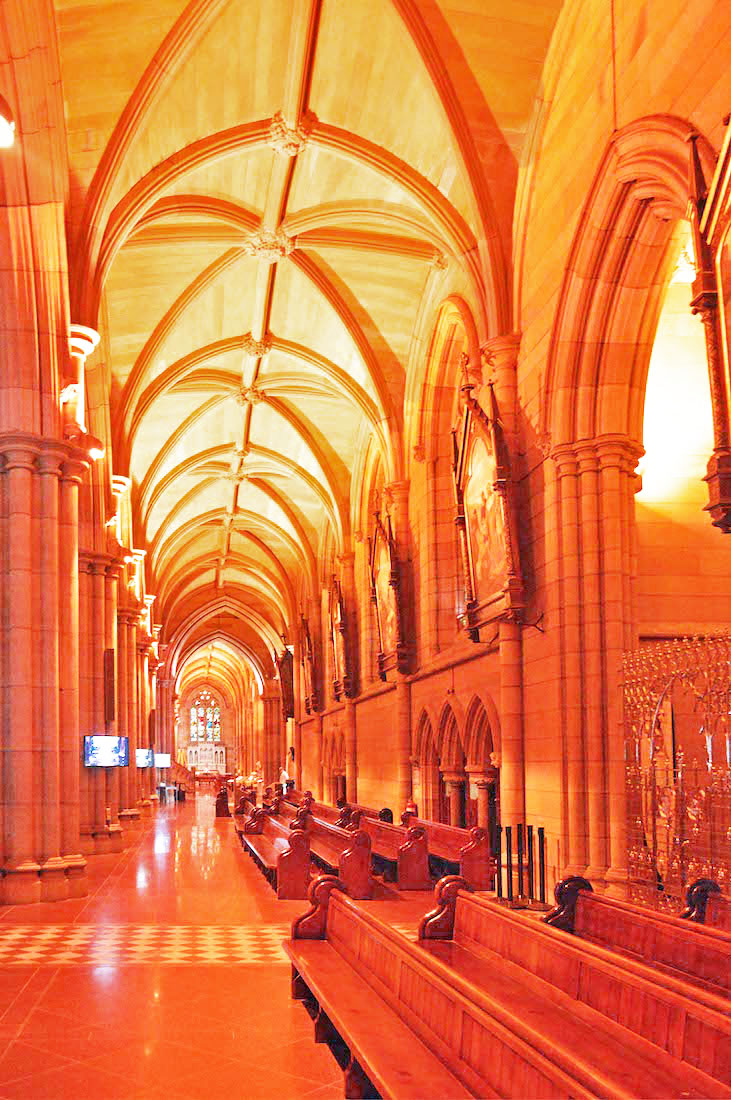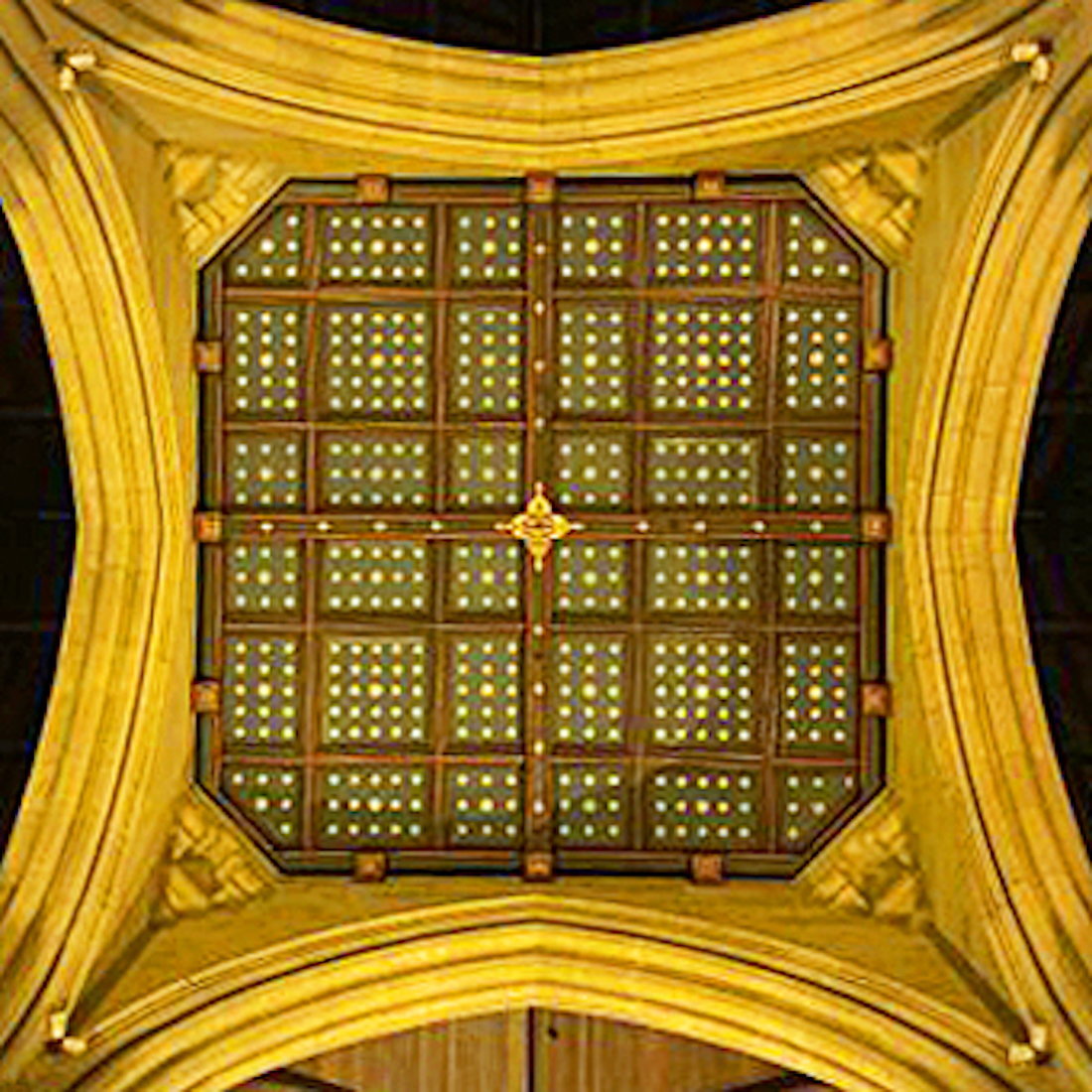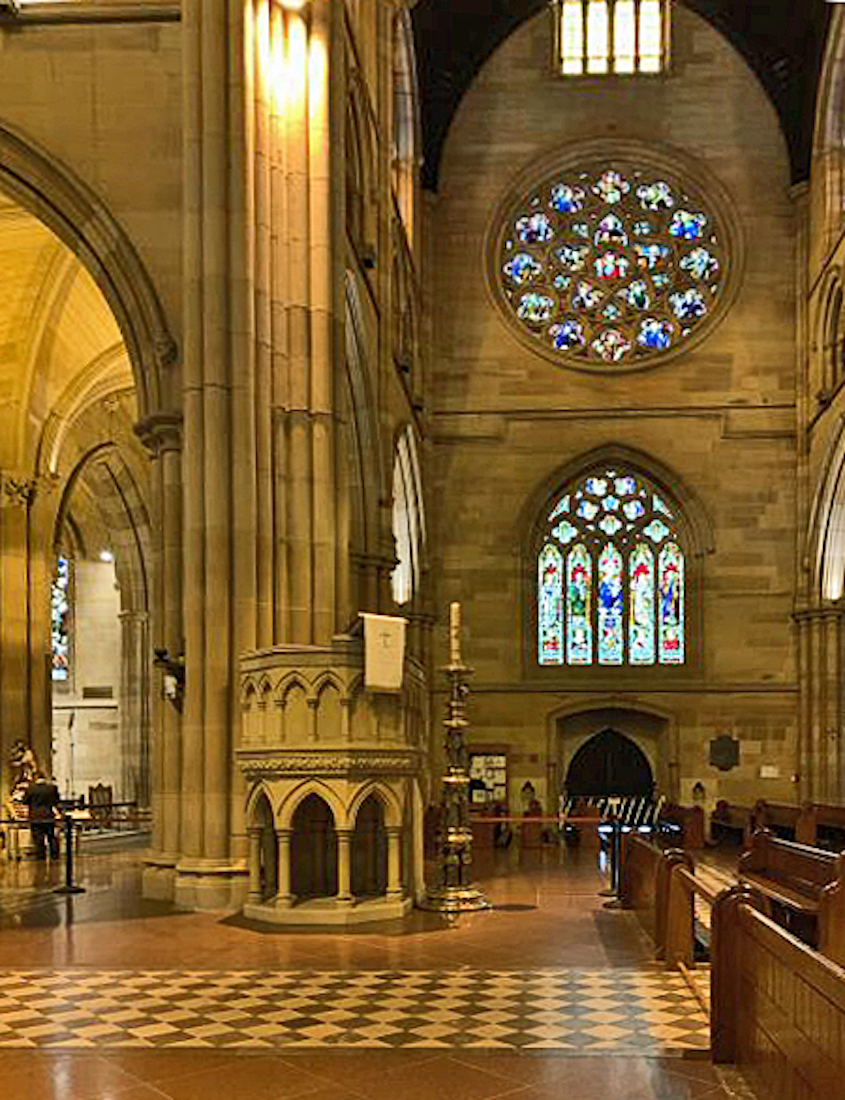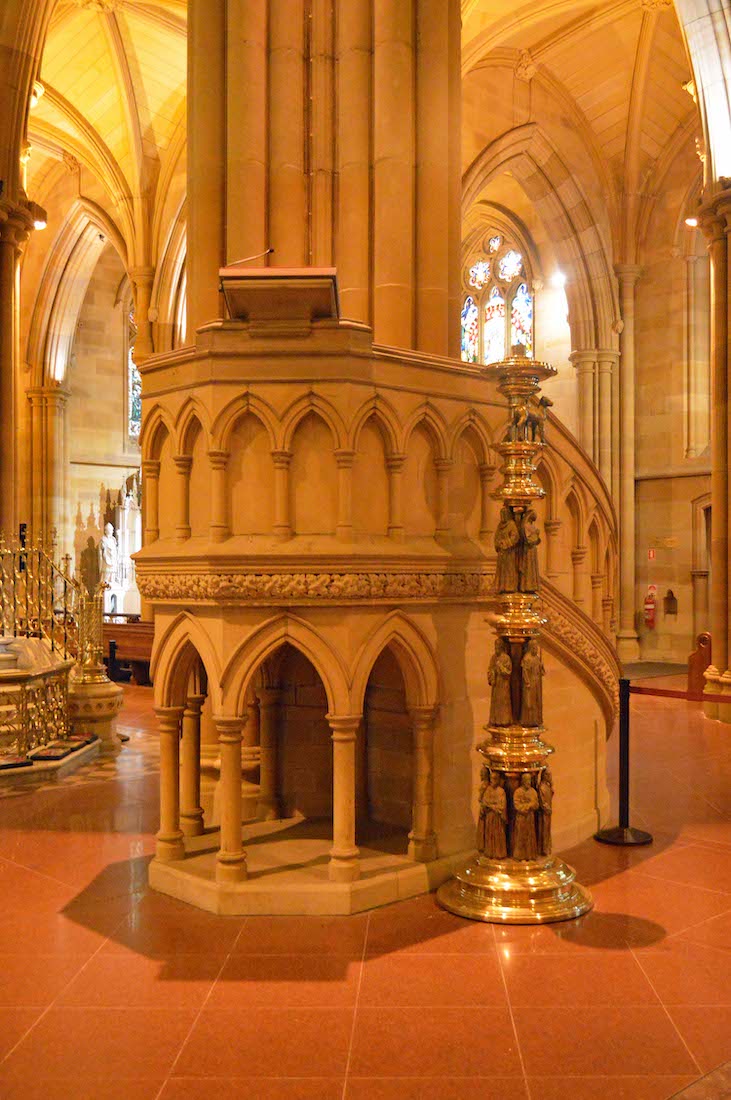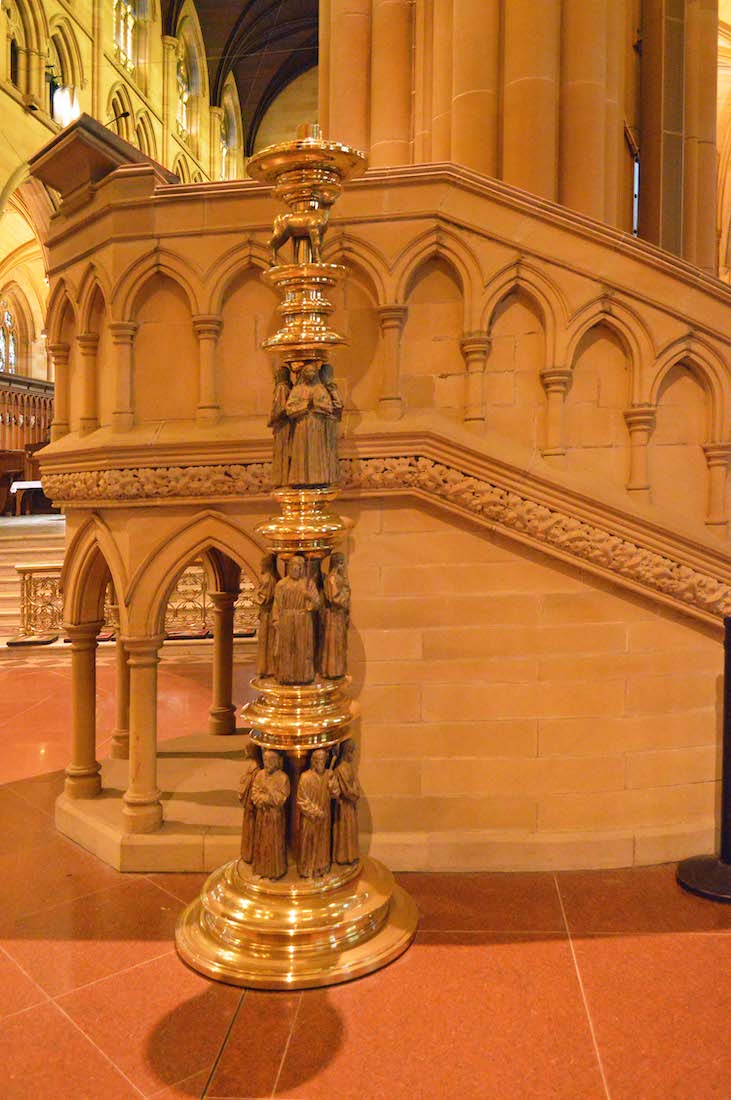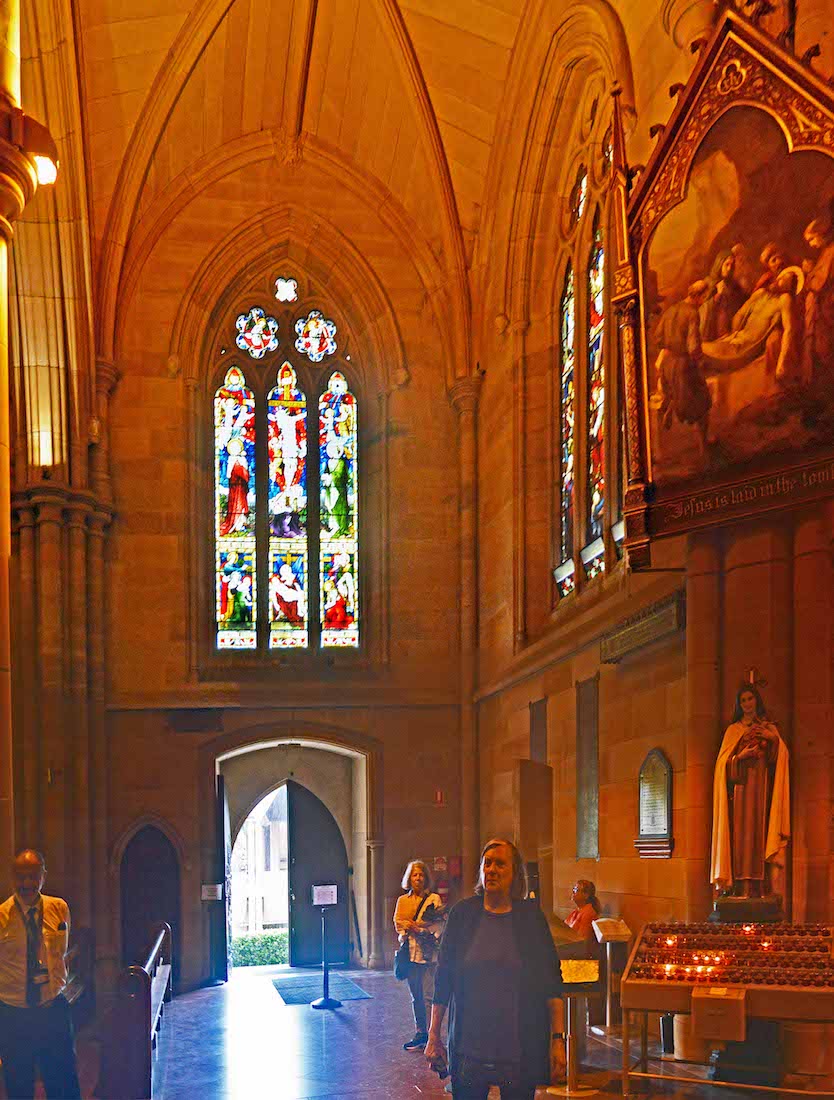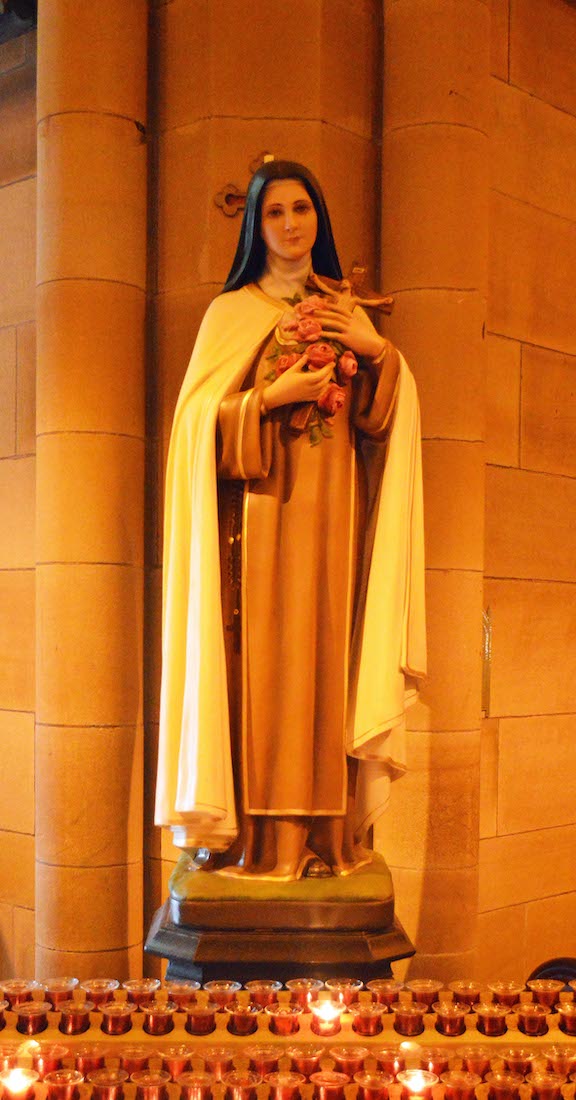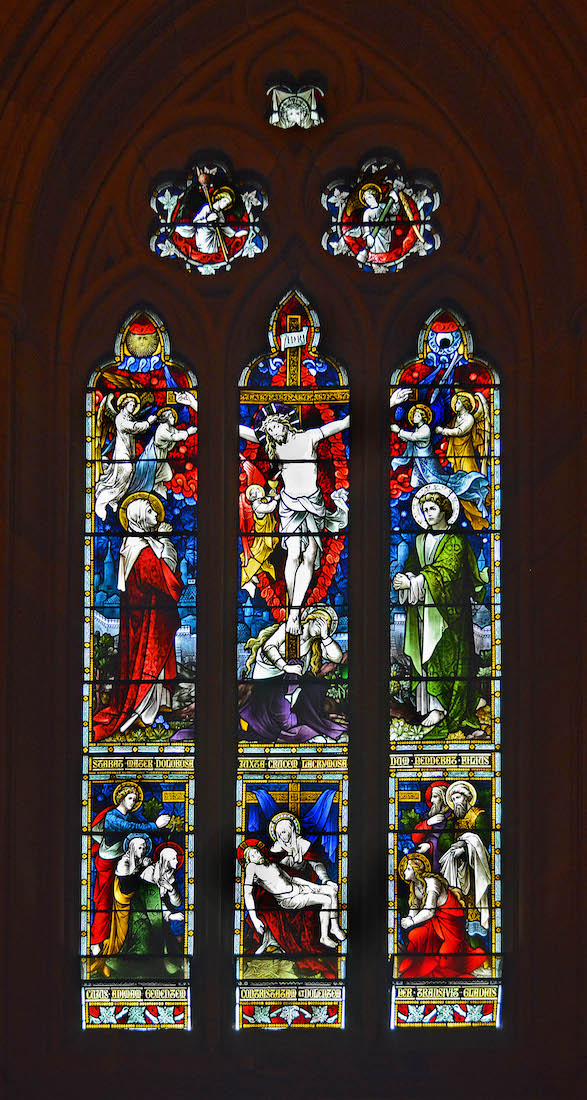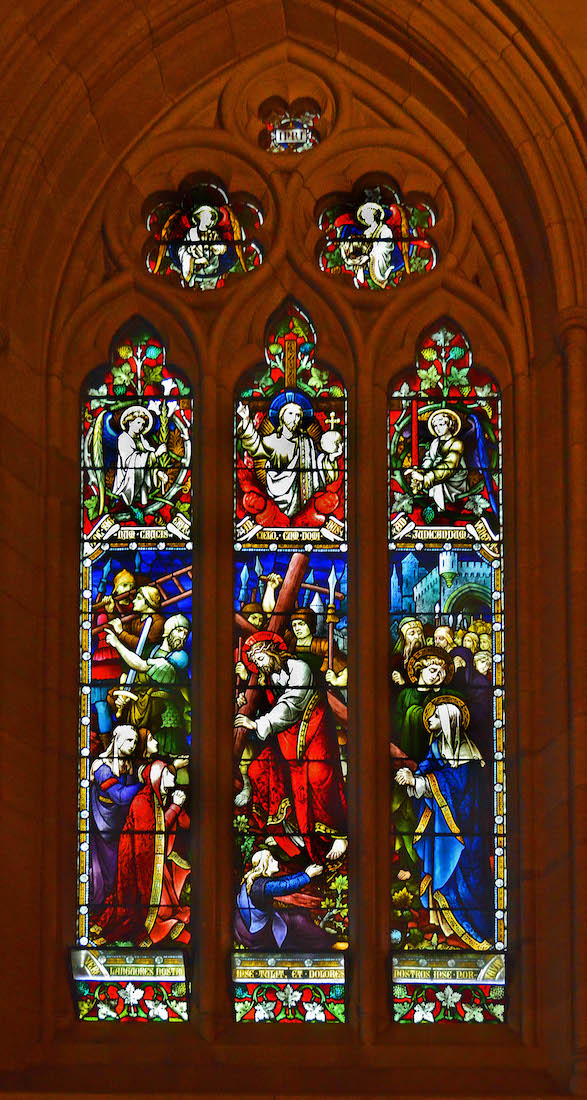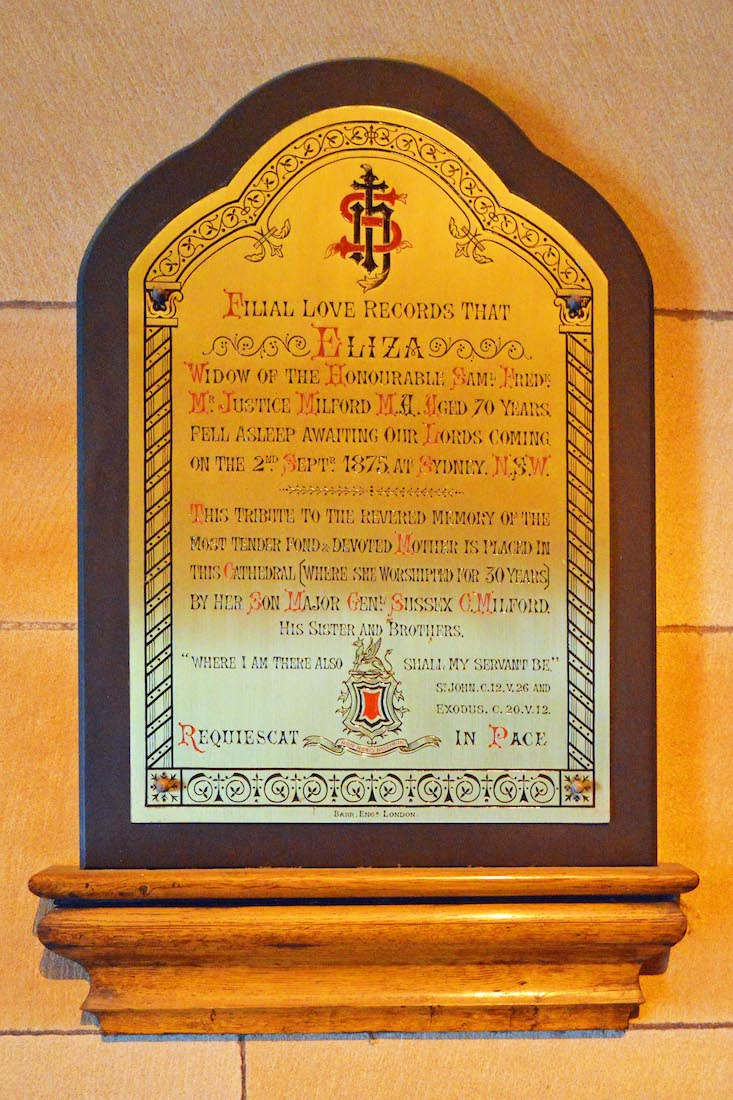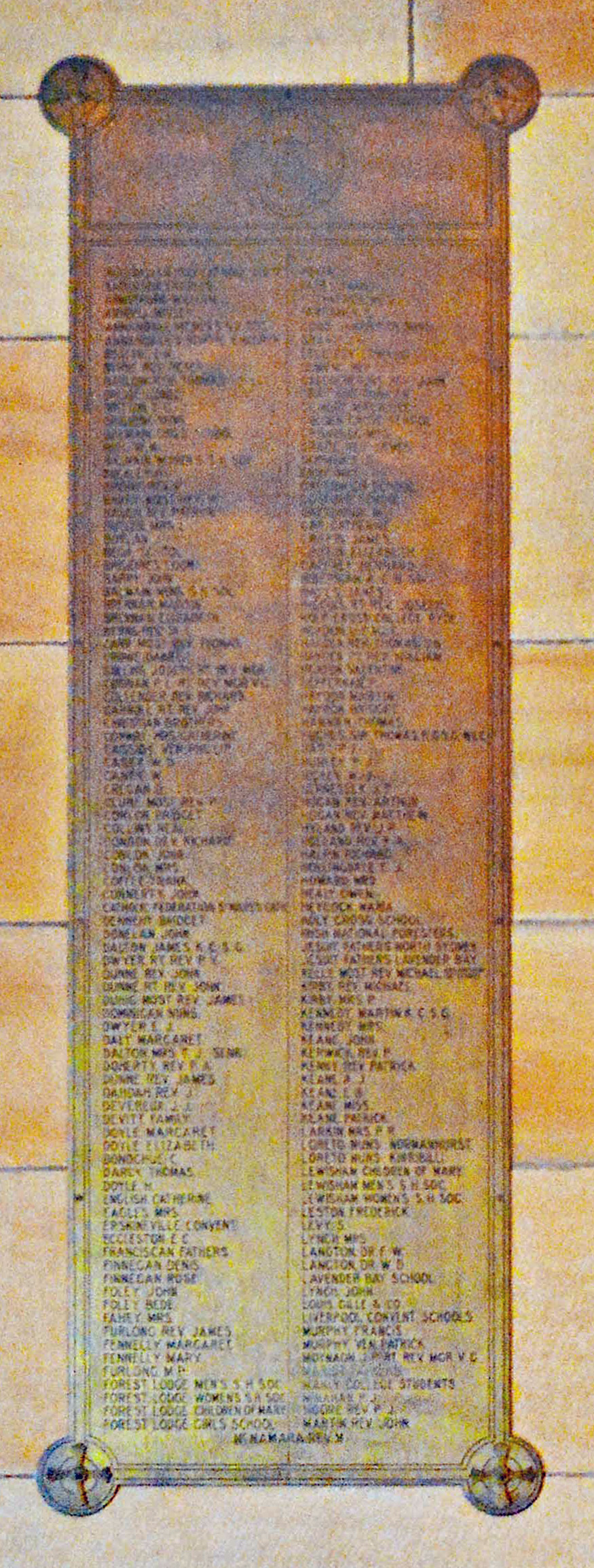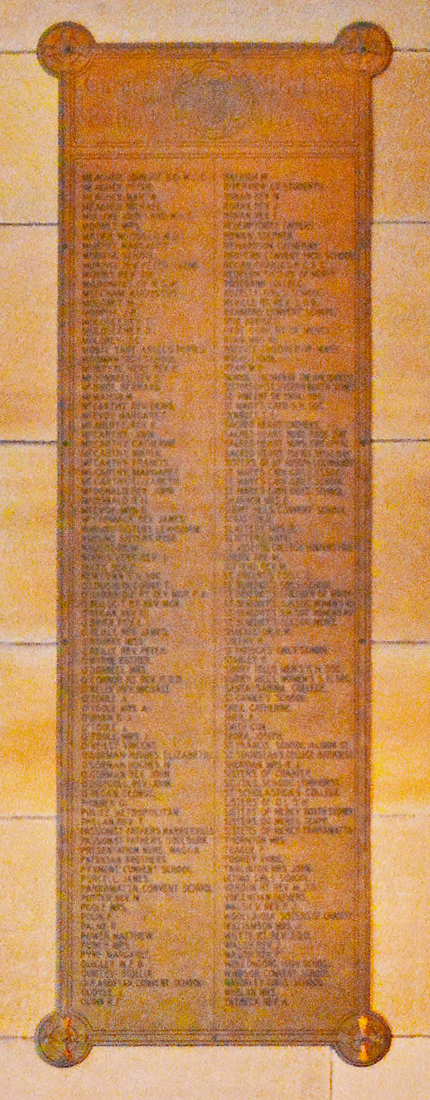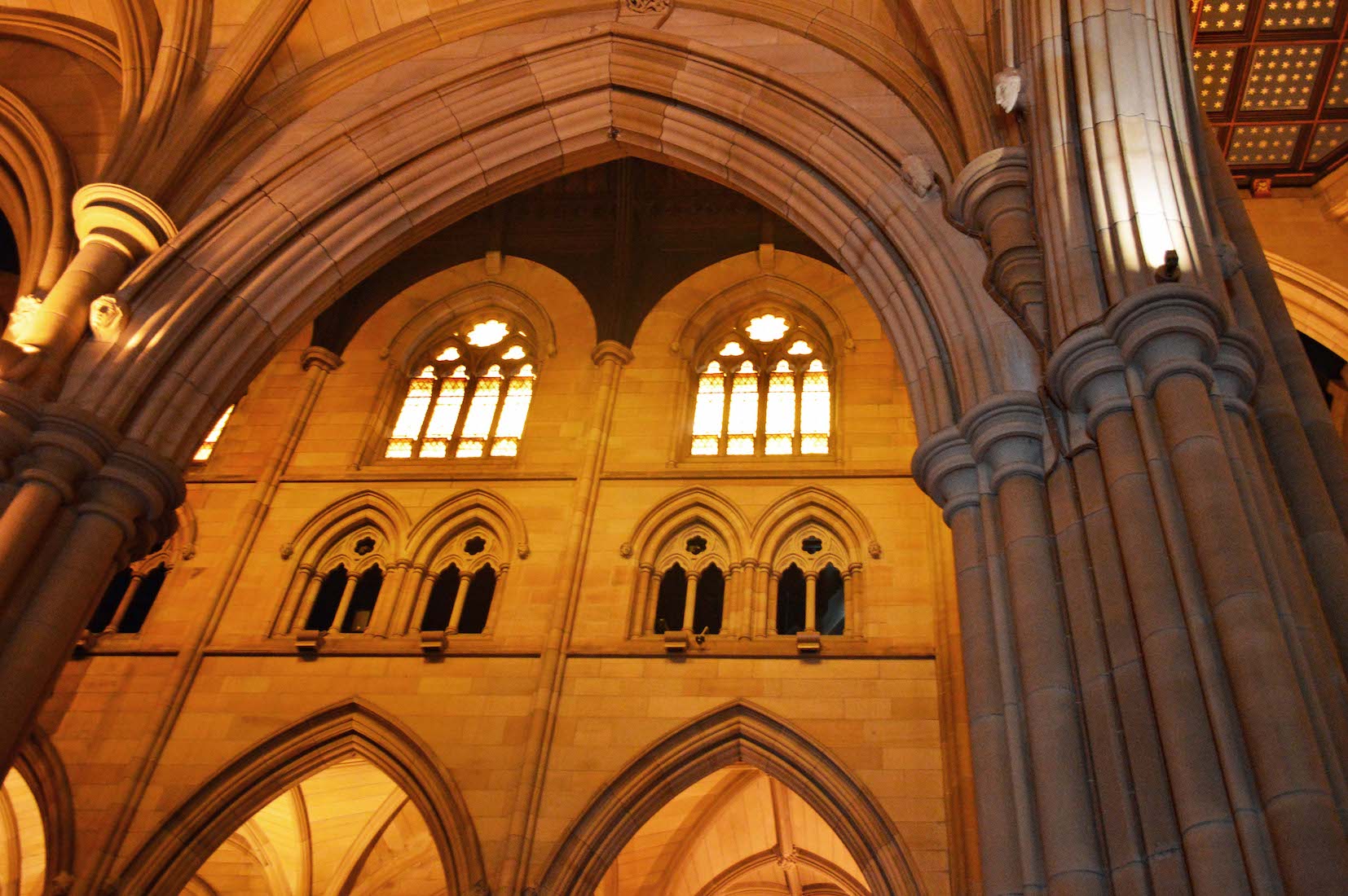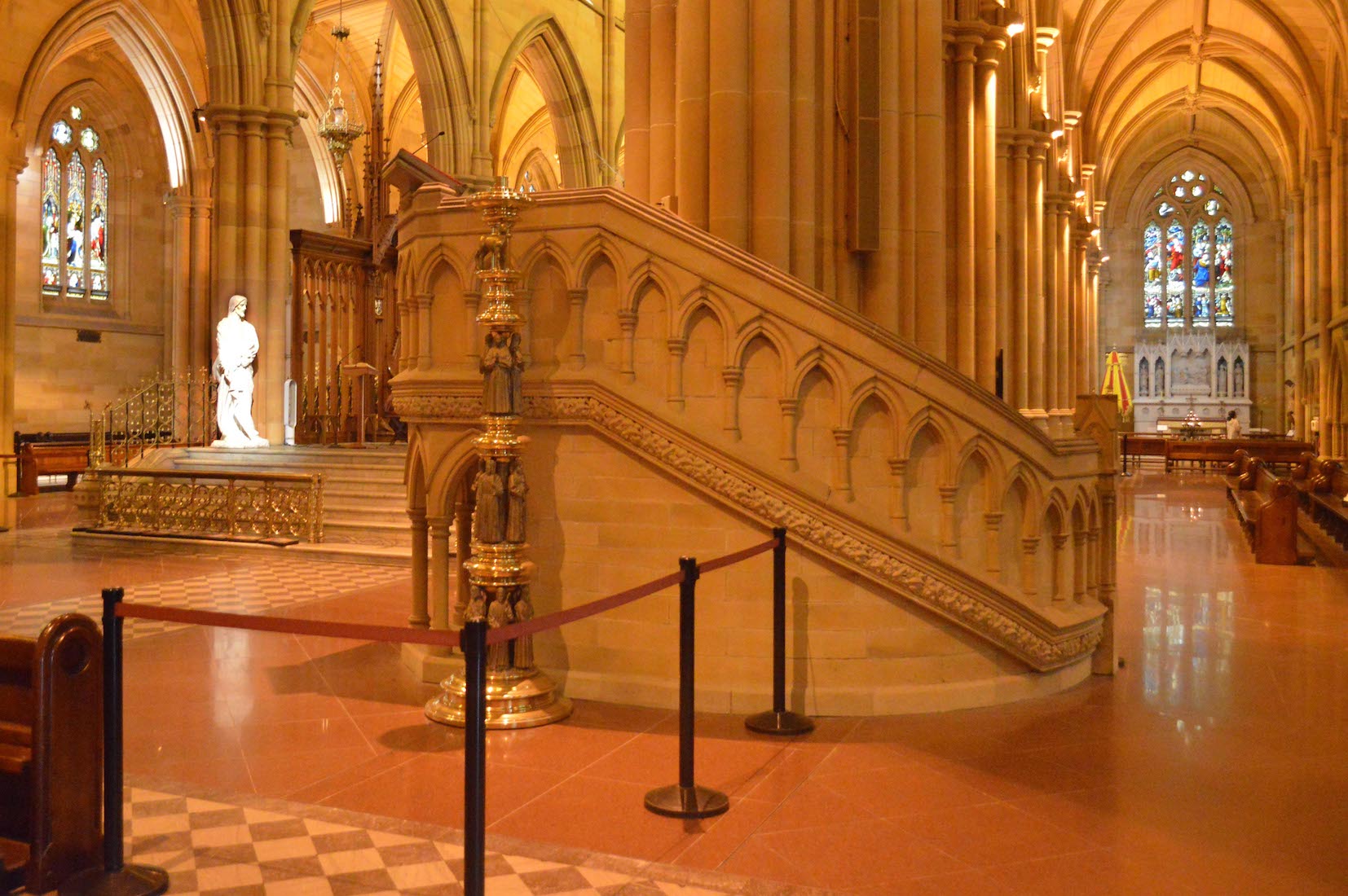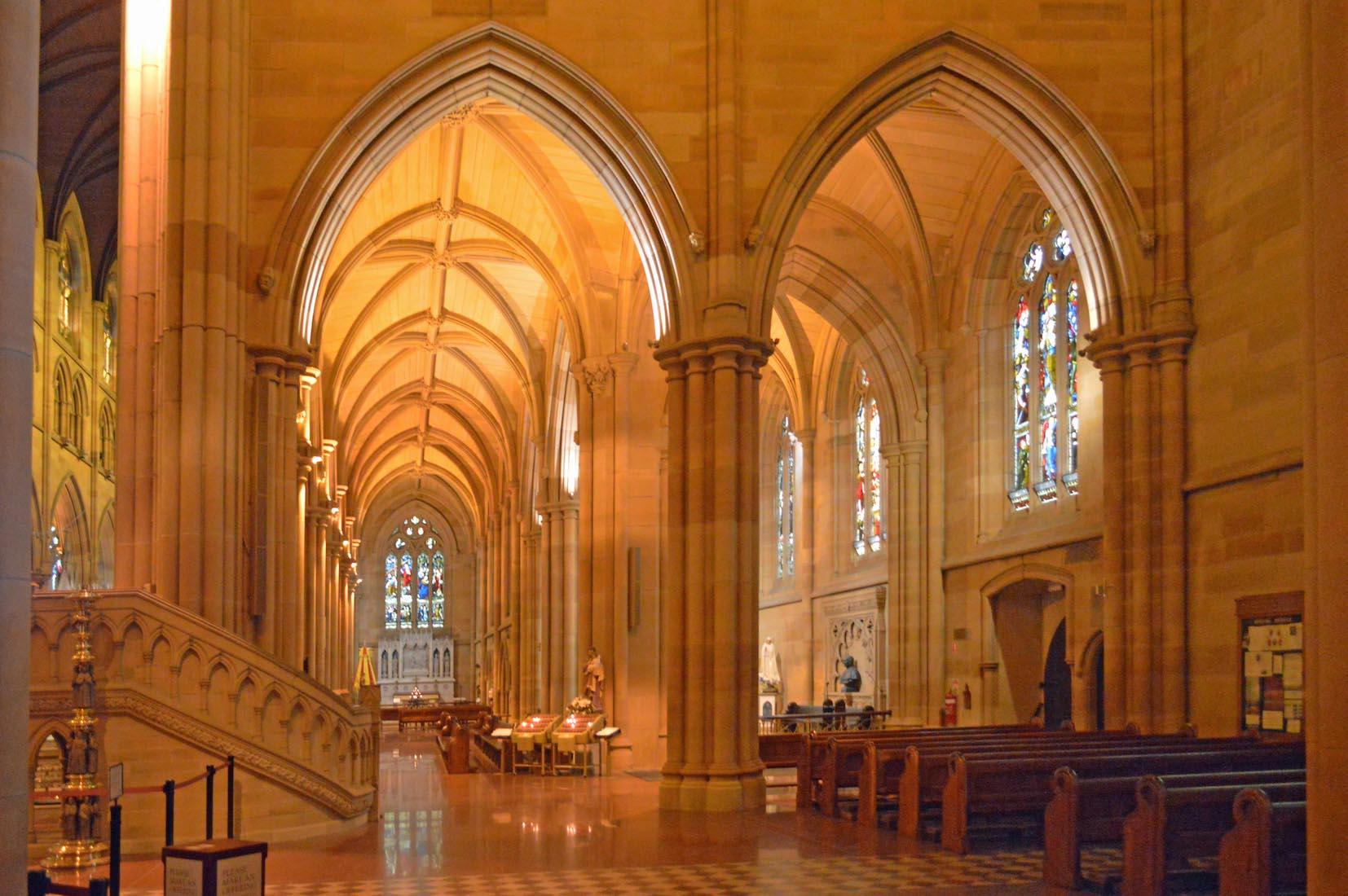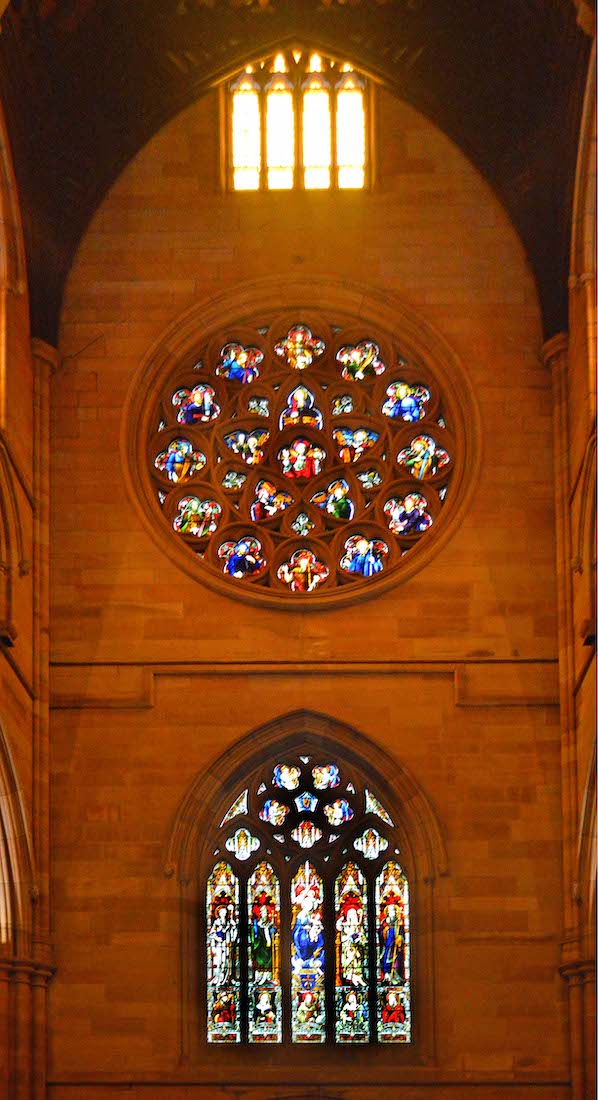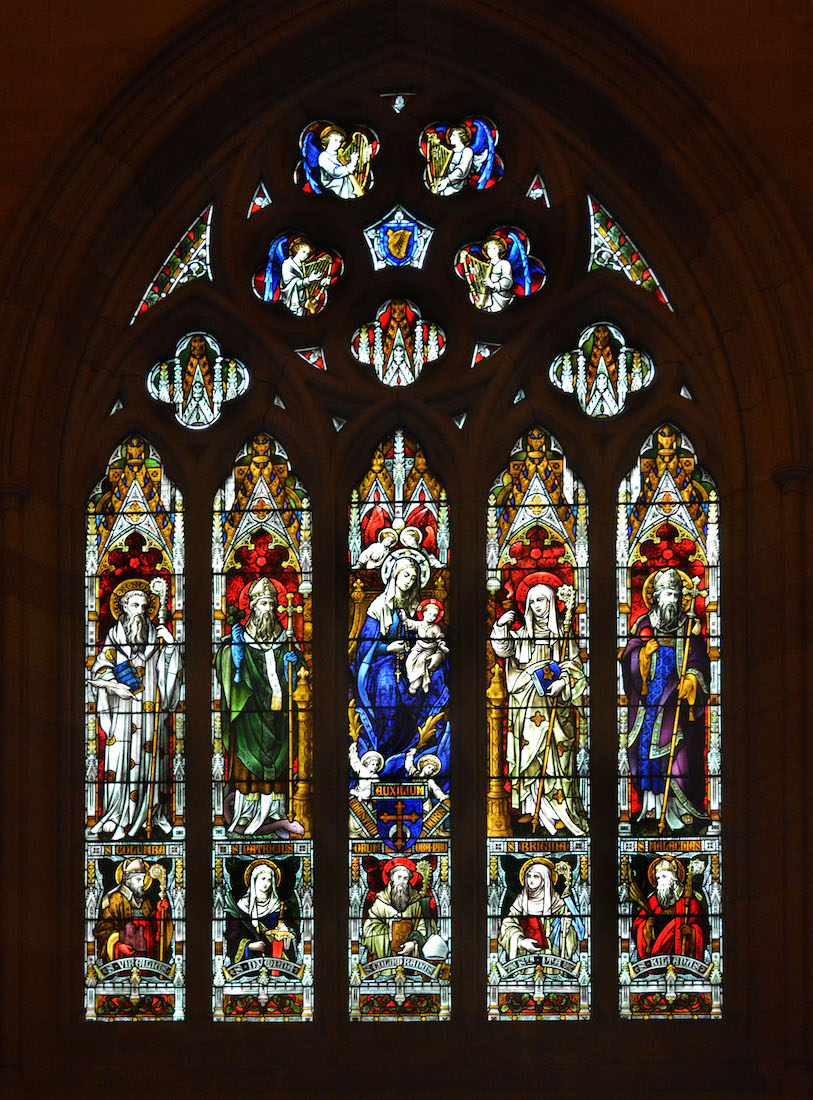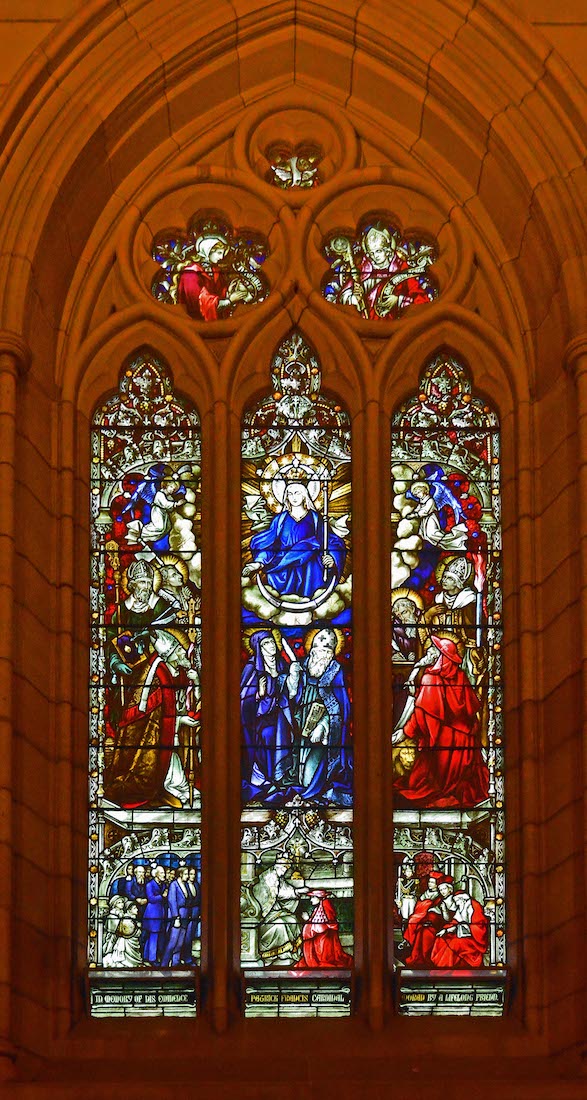
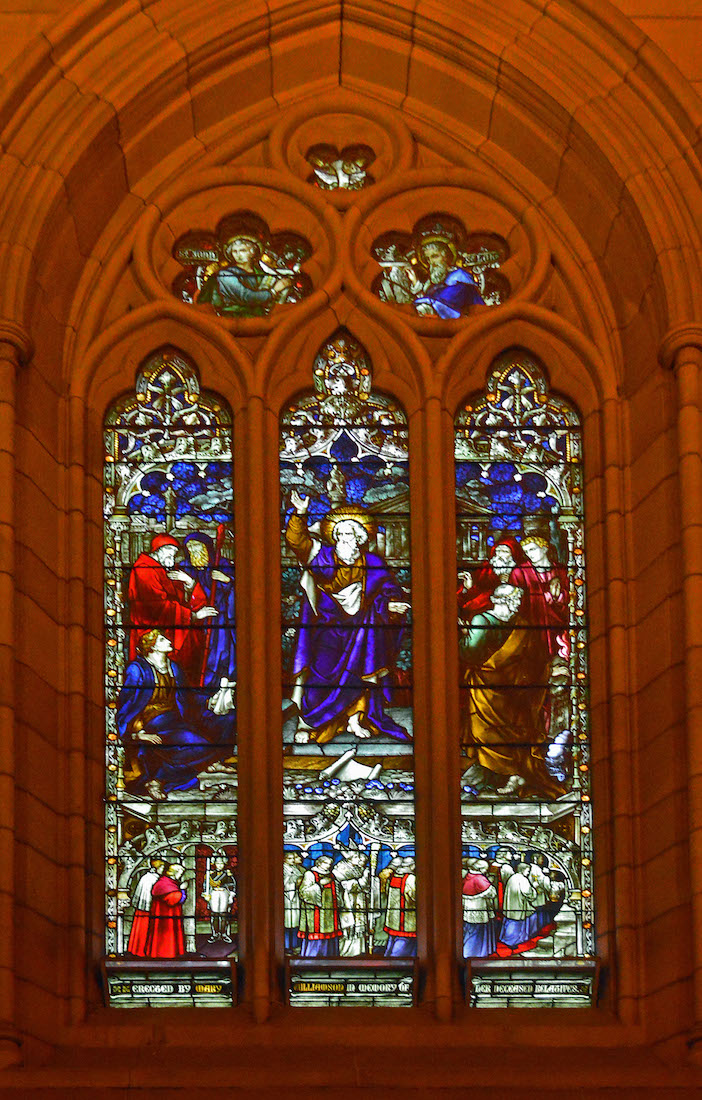
The next windows on the South side are Historical windows 6 and 5. ••• The central feature of the left window (HW6, 1885) is Mary as Queen of all Saints. The crescent appears under Mary’s feet in paintings of the Assumption (Meister of the Luzien-Legende, 1485) and signifies her glory and victory over time and space. She is surrounded by eight saints including seven Doctors of the Church. The lower historical scene is of Patrick Francis Moran being created cardinal in Rome by Pope Leo in 1885. ••• The window at right (HW5, 1882) St Paul preaching in Athens (Acts 17:16–34). The historical scenes below show a liturgical procession entering the first completed section of St Mary’s Cathedral in 1882. PLAN
42. SOUTH NAVE WALL
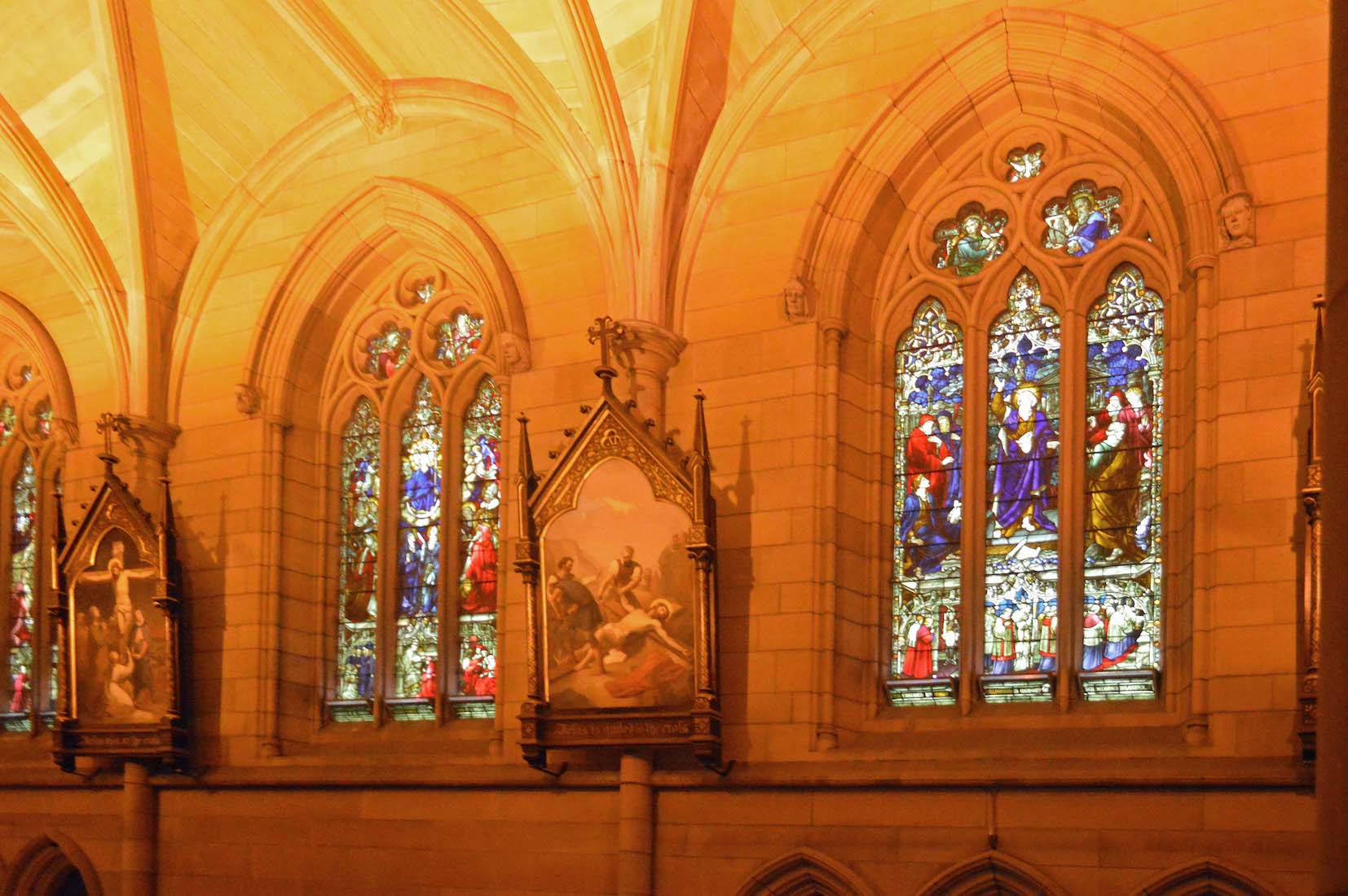
We continue our exploration along the South nave aisle.
44. BAPTISTRY VAULTING
The baptistry has a simple vaulted ceiling with arches rising to an ornate central boss.
45. BAPTISTRY WINDOWS I
The baptistry has five stained glass windows – all concerned with the theme of baptism and conversion to faith in Christ.
46. BAPTISTRY WINDOWS II
1,2 
3 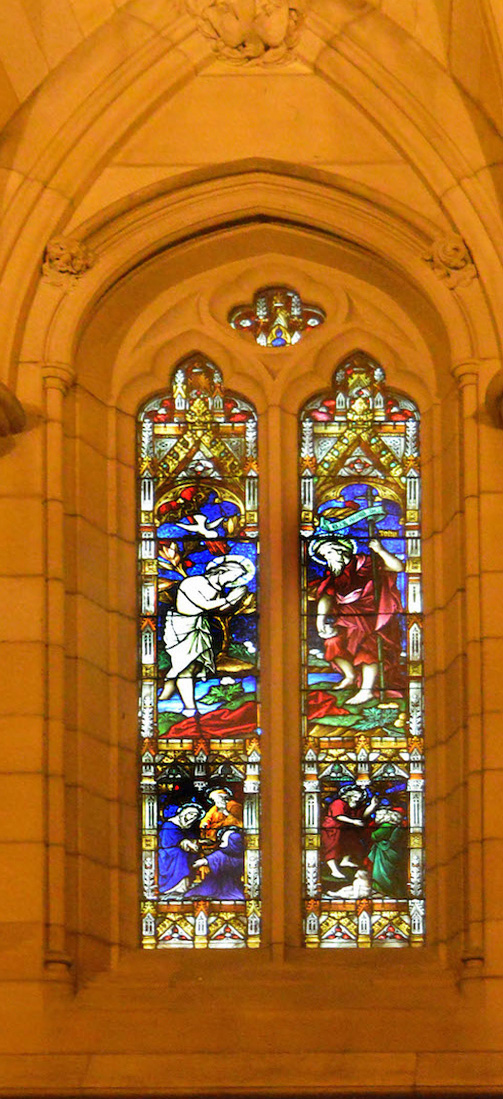 4,5
4,5 
From left we have: *** The baptism of Indians by St Francis Xavier (above) and St Paul baptising Lydia and her household. ••• Baptism of Emperor Constantine by Pope St Sylvester (above) and Philip baptising the Ethiopian eunuch, and Nicodemus speaking to Jesus (below). ••• The baptism of Christ by John the Baptist (above), and the Virgin Mary entering the house of Zachary, and John the Baptist preaching in the desert (below). ••• Ananaias laying hands on Paul (above) and baptising him (below). ••• St Patrick baptising (above), and lighting the Paschal fire, and entering Tara (below).
47. SOUTH NAVE AISLE
From the baptistry, we resume our investigation of the South nave aisle towards the West. The pattern of alternating windows and Stations of the Cross continues.
48. SOUTH NAVE WINDOWS 3, 2
The next two windows are the remaining Evangelist’s Windows. ••• The left window is St Mark’s Window. He is shown at the base, with his lion symbol and name. The main central panel of the left window records the healing work of Jesus with the raising of Jairus’s daughter. ••• The window at right is St Luke’s Window. Again he is shown at the base of the window along with his traditional symbol, the ox. The main panels show a happy family scene with the young Jesus at work in his father’s carpentry workshop making a small cross.
49. WELCOMING BISHOP AND SOUTH NAVE WINDOW 1
We have now returned to the West door where there is a welcoming bishop. Behind the bishop we can see a flight of steps leading up to the gallery, and across on the wall behind is the final nave window. The window shows St Thérèse of Lisieux kneeling before the Blessed Virgin and Christ Child. The inscription reads ‘Pray for the artists, living and dead, who worked on the windows of this cathedral, 1882-1930’. [Photo 2 Credit: Wikimedia, Jason7825]
50. SOUTH NAVE AISLE LOOKING EAST
We are going to walk back now to the crossing, following down the South aisle of the nave.
51. CROSSING ROOF, BELLS
The crossing in a cathedral is the intersection of the transepts with the East-West axis of the cathedral. There is almost always, as here, a square ceiling above – often highly decorated. ••• The tower above the crossing contains the bells of the Cathedral. The latest ring of 14 bells were ordered and rang for the first time in 1986. Change Ringing is the method of bell ringing used at the Cathedral where the bells stand upside down and are pulled by a rope by the bell ringer to allow the bell to rotate and ring in tune with the other bells. The Bells range in weight with the smallest weighing at 281kg whilst the heaviest weighs 1741kg. Each bell is named after a saint of the Church.
52. LOOKING TO THE SOUTH TRANSEPT
From the crossing we look South past the pulpit and Paschal candle to the South transept beyond. The transepts are interesting. From the exterior, each transept appears to have three parts: a central space with an end rose window, and a side aisle on either side, each with its own exit door. Inside, we easily find the central space and the adjoining West aisle. However, the Eastern transept ‘aisles’ merge straight into the East - West chancel aisles, with only the small exit doors to indicate their presence.
53. PULPIT AND PASCHAL CANDLE
The pulpit is quite large, but carved in a simple Gothic style with Gothic arch supports and decoration. Children who, over the years, have crawled into the arched space beneath the pulpit have discovered a beautiful carved roof boss, in miniature and usually unseen. The Paschal candlestick is a delight: three separate groups of robed figures at different levels, separated by circular brass dividers, and a deer standing at the top below the candle holder. The Paschal candle comes into prominence during the Easter period, illustrating that Christ is the Light of the world.
54. SOUTH TRANSEPT AND ST THERESE
Coming to the South transept, we first investigate the Western aisle. Here we find two stained glass windows, three plaques on the Western wall, and a statue of St Thérèse of Lisieux beneath the 14th Station of the Cross. •• Thérèse of Lisieux, born Marie Françoise-Thérèse Martin (1873 – 1897), also known as Saint Therese of the Child Jesus and the Holy Face, was a French Catholic Discalced (barefoot) Carmelite nun who is widely venerated in modern times. She is popularly known in English as the Little Flower of Jesus, or simply the Little Flower.
55. SOUTH TRANSEPT WINDOWS
The two windows in the South transept depict the 5th and 4th Sorrowful Mysteries of the Rosary. ••• The main panels of the window at left (SMR5) show a Crucifixion scene, with the smaller lower panels depicting the body of Jesus being taken down from the Cross. The window at right (SMR4) on the West wall of the transept, shows Jesus bearing his Cross as he makes his way to Calvary. At the top of the central panel is a small depiction of Jesus in glory.
56. SOUTH TRANSEPT PLAQUES
There are three plaques on the West wall of the South transept. The first is a memorial to Eliza Milford (d. 1875). Eliza was married to the senior judge Sam Fred Milford, and attended St Mary’s for 30 years, but one wonders why she deserved a special memorial plaque in a cathedral which has so few such memorials. The two brass plates at right constitute an Honours Roll for members of the Cathedral who gave their lives in two World Wars.
57. HIGH ARCHES
As we leave this aisle of the transept we look back to the high structure of the nave. There is a middle triforium layer which is included to increase the height of the nave, and then the top row of clerestory windows with their yellow glass.
58. PAST THE PULPIT TO THE SOUTH CHANCEL AISLE
We walk past the pulpit steps to explore the East end of the Cathedral. Notice the statue of St Joseph in the centre of the lower view, with the Chapel of Irish Saints just to the right, and next visible is the Eastern door of the South transept. But first we look at the central South transept windows which are on our right.
59. SOUTH TRANSEPT: EASTERN AISLE AND WINDOW
Here we have the South rose window, with a five-lancet stained glass window below. This is the Patronal Window showing Mary Help of Christians along with nine Irish saints. The text below the central figures is ‘Orum Christian Auxilium Dobis Oba Pro’ or, ‘Help of Christians, pray for us’. Clockwise from top left, he saints shown are St Columba, St Patrick, St Brigida, St Malachy, St Kilian, St Ita, St Columbanus and St Dymphna. Angels play harps at the top of the window.
60. SOUTH TRANSEPT ROSE WINDOW
The West rose window depicts Adam with the prophets and patriarchs. It is based on the text: ‘As in Adam all die, also in Christ shall all be made alive’ (1 Cor 15:22). Clockwise from top, the outer quatrefoils show Peter with keys, James the Greater with pilgrim’s staff, Bartholomew with knife, Simon with saw, Jude with boat, Matthias with spear, John the Baptist, Matthew with staff and money bag, James the Less with club and book, Philip with cross and loaves, Thomas with builder’s square, and Andrew with his X-shaped cross. Closer to the central figure we see St Paul with sword, Luke with winged ox, John with eagle, Mark with winged lion, and Matthew with an angel.


